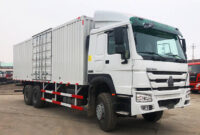4 By 4 Trucks For Sale: Your Ultimate Guide to Off-Road and On-Road Versatility pickup.truckstrend.com
The rumble of a powerful engine, the capability to conquer any terrain, and the sheer utility of a robust pickup truck – these are the hallmarks of a 4×4 truck. More than just vehicles, 4×4 trucks represent freedom, resilience, and the power to tackle challenges, whether that’s a remote trail, a heavy load, or a snow-choked highway. For many, a 4×4 truck isn’t just a purchase; it’s an investment in a lifestyle that demands more from a vehicle.
If you’re in the market for a new or used truck, the term "4 By 4 Trucks For Sale" opens up a world of possibilities. But with so many options, features, and considerations, navigating the market can be daunting. This comprehensive guide will walk you through everything you need to know about finding, evaluating, and purchasing the perfect 4×4 truck to suit your needs and aspirations.
4 By 4 Trucks For Sale: Your Ultimate Guide to Off-Road and On-Road Versatility
What Makes a 4×4 Truck Special? Understanding the Drivetrain
At its core, a 4×4 (four-by-four) truck is distinguished by its drivetrain, which allows power to be sent to all four wheels simultaneously. Unlike a traditional 2WD (two-wheel drive) vehicle that only powers the front or rear axle, a 4×4 system provides superior traction and control, especially in challenging conditions.
Most 4×4 trucks feature a transfer case, which is a gearbox that sits between the transmission and the drive shafts to the front and rear axles. This transfer case allows the driver to select different drive modes:
- 2H (Two-Wheel Drive, High Range): Power is sent only to the rear wheels (most common for daily driving, fuel efficiency).
- 4H (Four-Wheel Drive, High Range): Power is sent to all four wheels, suitable for slippery conditions like snow, gravel, or light off-road trails.
- 4L (Four-Wheel Drive, Low Range): Provides maximum torque multiplication for extreme off-road situations, steep climbs, or heavy pulling at very low speeds.
- Auto 4WD (Optional): Some modern systems can automatically engage 4WD when slip is detected.

This ability to distribute power across all four wheels is what gives 4×4 trucks their legendary capability and makes them indispensable for specific tasks and environments.
The Undeniable Benefits of Owning a 4×4 Truck
The appeal of a 4×4 truck extends far beyond its rugged good looks. Here are some of the key advantages that make them a popular choice:
- Unrivaled Off-Road Capability: This is arguably the primary draw. With enhanced traction, higher ground clearance (often), and the ability to engage low-range gearing, 4×4 trucks can traverse mud, sand, rocks, and steep inclines that would stop a 2WD vehicle in its tracks.
- Superior Performance in Adverse Weather: Snow, ice, heavy rain – these conditions become far less daunting with a 4×4. The increased grip helps maintain control, reduce slippage, and ensures you reach your destination safely.
- Enhanced Towing and Hauling: While 2WD trucks can tow, 4×4 models often offer better stability and traction when pulling heavy trailers, especially on unpaved surfaces or boat ramps. The extra weight distribution provided by 4WD helps manage the load more effectively.
- Increased Resale Value: Due to their versatility and demand, 4×4 trucks generally hold their value better than their 2WD counterparts. This makes them a smart investment if you plan to sell or trade in down the line.
- Versatility for Work and Play: From construction sites and farm work to weekend adventures and daily commuting, a 4×4 truck adapts to a wide range of tasks, making it a true multi-purpose vehicle.
- Peace of Mind: Knowing your vehicle can handle unexpected terrain or weather conditions provides a significant sense of security, especially for those who live in rural areas or frequently travel off the beaten path.


Navigating the Landscape: Types of 4×4 Trucks Available
The market for 4×4 trucks is incredibly diverse, catering to various budgets, needs, and preferences. Understanding the main categories can help you narrow down your search:
- Compact/Mid-Size 4×4 Trucks: These are smaller, more nimble trucks that offer a balance of capability and fuel efficiency.
- Examples: Toyota Tacoma, Ford Ranger, Chevrolet Colorado, Nissan Frontier.
- Ideal for: Light off-roading, city driving, smaller towing needs, those seeking better maneuverability and fuel economy than a full-size truck.
- Full-Size Light-Duty 4×4 Trucks: The most popular segment, offering a blend of daily drivability, strong towing/hauling capabilities, and comfortable interiors.
- Examples: Ford F-150, Ram 1500, Chevrolet Silverado 1500, Toyota Tundra.
- Ideal for: General purpose use, moderate to heavy towing, family hauling, and serious recreational off-roading (especially with dedicated off-road trims).
- Heavy-Duty (HD) 4×4 Trucks: Built for maximum towing, hauling, and commercial applications. These trucks are robust and often come with powerful diesel engine options.
- Examples: Ford F-250/350, Ram 2500/3500, Chevrolet Silverado 2500/3500.
- Ideal for: Heavy equipment towing, large RVs, commercial use, and extreme off-road recovery.
- Specialty/Off-Road Focused 4×4 Trucks: These trucks are designed from the ground up with serious off-roading in mind, often featuring enhanced suspension, locking differentials, and protective skid plates.
- Examples: Jeep Gladiator, Ford Bronco (some trims), Ford F-150 Raptor, Ram 1500 TRX.
- Ideal for: Dedicated off-road enthusiasts, rock crawling, desert running, and those who prioritize extreme capability over daily driving comfort or fuel economy.
Key Considerations When Buying a 4×4 Truck
Purchasing a 4×4 truck requires careful thought. Here’s a checklist of important factors to consider:
-
Define Your Primary Purpose:
- Off-roading: Look for specific off-road packages, higher ground clearance, skid plates, locking differentials, and robust suspension.
- Towing/Hauling: Focus on engine type (diesel often preferred for HD), towing capacity, payload capacity, and integrated trailer brakes.
- Daily Driver: Prioritize comfort, fuel economy, safety features, and infotainment.
- Work Truck: Durability, bed utility, and a practical interior might be key.
-
Budget: New vs. Used:
- New: Offers the latest technology, warranty, and customization options. Higher initial cost and faster depreciation.
- Used: More affordable, less depreciation, but requires thorough inspection. Consider certified pre-owned (CPO) for added peace of mind.
-
Engine Type:
- Gasoline: Generally less expensive upfront, lower maintenance costs, good for general use.
- Diesel: Higher torque for towing/hauling, better fuel economy (especially under load), but higher upfront cost and potentially more expensive maintenance.
-
Transmission:
- Automatic: Most common, easy to drive, excellent for towing.
- Manual: Offers more driver control, preferred by some off-road enthusiasts, but less common and can be less convenient in traffic.
-
Cab and Bed Configuration:
- Regular Cab: Two doors, smallest interior, longest bed option.
- Extended Cab (King Cab, Double Cab): Two full-size front doors, smaller rear doors, limited rear seating.
- Crew Cab (SuperCrew, CrewMax): Four full-size doors, spacious rear seating, popular for families.
- Bed Lengths: Short (5-5.5 ft), Standard (6.5 ft), Long (8 ft). Choose based on what you need to carry.
-
Condition (for Used Trucks):
- Rust: Inspect the frame, body panels, and suspension components thoroughly, especially in regions with road salt.
- Drivetrain: Check for leaks, unusual noises, and proper engagement of 4×4 modes.
- Suspension: Look for worn shocks, springs, or bushings.
- Tires: Ensure even wear, which indicates proper alignment and suspension health.
-
Features and Technology: Consider infotainment systems, safety features (adaptive cruise control, lane departure warning), parking sensors, rearview cameras, and specialized off-road features like crawl control or multi-terrain select.
-
Aftermarket Modifications: If buying used, be wary of poorly executed modifications. Well-done mods (lifts, tires, bumpers) can add value, but ensure they were installed professionally and don’t compromise safety or reliability.
Where to Find 4×4 Trucks For Sale
The search for your ideal 4×4 truck can take you to several places:
- Dealerships (New and Used): Offer a wide selection, financing options, warranties, and trade-in services. New vehicle dealerships also sell certified pre-owned trucks.
- Online Automotive Marketplaces: Websites like Autotrader, Cars.com, CarGurus, and Edmunds allow you to filter by make, model, year, price, and 4×4 capability, providing access to thousands of listings from both dealerships and private sellers.
- Private Sellers: Often found on Craigslist, Facebook Marketplace, or local classifieds. Can offer lower prices, but require more due diligence (inspections, history reports).
- Auctions: Can yield great deals but come with risks as vehicles are sold "as-is" and typically cannot be thoroughly inspected beforehand.
- Specialty Off-Road Shops: Some shops specialize in building and selling customized 4×4 vehicles, often with extensive modifications.
Tips for a Successful 4×4 Truck Purchase
- Do Your Research: Understand the common issues, pros, and cons of specific makes and models you’re considering. Read reviews, watch videos, and join owner forums.
- Test Drive Extensively: Don’t just drive on pavement. If possible, test the 4×4 system in a safe, controlled off-road environment (e.g., a gravel road, a field) to ensure it engages properly and smoothly.
- Get a Pre-Purchase Inspection (PPI): This is crucial, especially for used trucks. Have an independent, trusted mechanic inspect the vehicle, paying close attention to the drivetrain, frame, and suspension.
- Check the Vehicle History Report: Services like CarFax or AutoCheck provide valuable information on accidents, service records, ownership history, and title issues.
- Negotiate Wisely: Be prepared to negotiate the price, whether at a dealership or with a private seller. Know the market value of the truck you’re interested in.
- Understand Financing and Insurance: Get pre-approved for a loan if possible. Research insurance costs, as 4×4 trucks can sometimes be more expensive to insure due to their higher value and potential for off-road use.
Potential Challenges and Solutions
While the benefits are numerous, owning a 4×4 truck does come with a few potential challenges:
- Fuel Economy: 4×4 systems and the added weight of larger components can reduce fuel efficiency.
- Solution: Consider smaller engines, newer models with advanced fuel-saving technologies (e.g., cylinder deactivation, hybrid options), or adjust your driving habits.
- Maintenance Costs: Heavier-duty components and more complex drivetrains can sometimes lead to higher maintenance and repair costs.
- Solution: Adhere to the manufacturer’s recommended maintenance schedule, budget for potential repairs, and consider a warranty for new trucks.
- Size and Maneuverability: Full-size and HD 4×4 trucks can be challenging to park and maneuver in tight urban spaces.
- Solution: Practice driving and parking, utilize parking assist features and cameras, or opt for a mid-size truck if space is a major concern.
- Initial Cost and Depreciation: New 4×4 trucks can be a significant investment, and like any vehicle, they depreciate.
- Solution: Consider buying a well-maintained used truck to let the first owner absorb the initial depreciation, or choose models known for strong resale value.
Representative Price Guide for 4×4 Trucks For Sale
Please note: Prices are highly variable based on make, model, year, mileage, condition, trim level, engine, features, and geographic location. This table provides a general estimated range for typical models.
| Category | Typical Models | New Price Range (Est.) | Used Price Range (Est. 5-10 yrs old) | Key Considerations |
|---|---|---|---|---|
| Compact/Mid-Size | Toyota Tacoma, Ford Ranger, Chevy Colorado | $30,000 – $55,000+ | $15,000 – $35,000+ | Maneuverability, Fuel Economy, Light Off-Road |
| Full-Size Light-Duty | Ford F-150, Ram 1500, Chevy Silverado 1500 | $45,000 – $80,000+ | $25,000 – $55,000+ | Versatility, Towing/Hauling, Daily Comfort |
| Heavy-Duty | Ford F-250/350, Ram 2500/3500, Chevy 2500/3500 | $55,000 – $100,000+ | $30,000 – $70,000+ | Max Towing/Payload, Diesel Options, Commercial Use |
| Specialty Off-Road | Jeep Gladiator, Ford Raptor, Ram TRX | $40,000 – $100,000+ | $30,000 – $80,000+ (for specific trims) | Extreme Capability, Performance, Dedicated Off-Road Use |
Disclaimer: These ranges are estimates and can vary significantly. Always research specific vehicles and compare prices from multiple sources.
Frequently Asked Questions (FAQ) About 4×4 Trucks
Q1: Is 4×4 necessary for daily driving?
A1: No, 4×4 is not necessary for typical daily driving on paved roads. For most commuters, a 2WD truck is sufficient. 4×4 becomes necessary for off-road trails, unpaved surfaces, heavy snow, or when maximum traction is required for towing or challenging conditions.
Q2: What’s the difference between 4WD and AWD?
A2: While often used interchangeably by the public, there’s a technical distinction. 4WD (Four-Wheel Drive) systems are typically part-time, meaning the driver manually engages 4WD (e.g., 4H, 4L) for specific challenging conditions. They often lack a center differential, meaning they shouldn’t be used on dry pavement in 4WD as it can cause drivetrain binding. AWD (All-Wheel Drive) systems are generally full-time or automatic, designed to operate on all surfaces (including dry pavement) by continuously or automatically distributing power to all wheels. Most "4×4 trucks" refer to traditional 4WD systems, though some modern trucks offer an "Auto 4WD" mode similar to AWD.
Q3: Are 4×4 trucks bad on gas?
A3: Generally, yes, 4×4 trucks tend to have lower fuel economy than their 2WD counterparts. This is due to the added weight of the 4×4 components, increased drivetrain friction, and often larger engines and tires. However, advancements in engine technology and lighter materials are improving efficiency in newer models.
Q4: What should I look for when buying a used 4×4 truck?
A4: Prioritize a pre-purchase inspection by a trusted mechanic. Specifically check for rust on the frame, body, and suspension components. Test the 4×4 system thoroughly (engage 4H and 4L, listen for unusual noises). Examine the tires for even wear, indicating proper alignment. Look for fluid leaks, especially around the differentials and transfer case. Check service records for regular maintenance.
Q5: Can I convert a 2WD truck to 4×4?
A5: While technically possible, converting a 2WD truck to 4×4 is a complex, expensive, and labor-intensive process. It typically involves replacing the front axle, transfer case, transmission, drive shafts, and potentially modifying the suspension and frame. It’s almost always more cost-effective and reliable to simply buy a factory 4×4 truck.
Q6: How often should I engage 4×4?
A6: For part-time 4WD systems (common in 4×4 trucks), you should only engage 4H or 4L when traction is limited (e.g., snow, mud, gravel, sand) and never on dry, hard pavement. Using 4WD on dry pavement can cause drivetrain binding and damage due to the lack of slippage between the tires. It’s a good idea to engage 4H for a few miles once a month (on a loose surface) to keep the components lubricated and functioning properly.
Conclusion
The market for "4 By 4 Trucks For Sale" is vast and offers a compelling range of options for nearly every need and budget. From the compact adventurer to the heavy-duty workhorse, these vehicles embody capability, resilience, and versatility. By understanding the different types, carefully considering your specific requirements, and following smart buying practices, you can confidently navigate the buying process.
A 4×4 truck isn’t just a mode of transport; it’s a tool for exploration, a reliable partner for tough jobs, and a vessel for adventure. With the right choice, your 4×4 truck will serve you faithfully, opening up new possibilities on the road less traveled, and ensuring you’re ready for whatever challenges lie ahead. Happy hunting!



